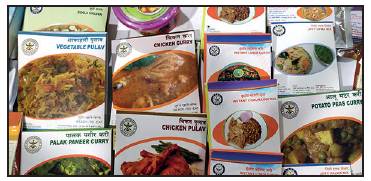Defence Food Research Laboratory (DFRL), Mysuru
This is a collection of articles archived for the excellence of their content. |
Astronauts’ food
As in 2020
Chethan Kumar, January 7, 2020: The Times of India

From: Chethan Kumar, January 7, 2020: The Times of India
BENGALURU: From suji halwa to chicken biryani, a menu of about 30 dishes has been readied for astronauts proposed to be sent to space as part of India’s first human spaceflight mission (Gaganyaan). The menu will now be evaluated by the Indian Space Research Organisation (Isro) and the astronauts.
The special ready-to-eat dishes — an elaborate spread ranging from fruit juices to energy bars and regular Indian cuisines — are being developed by the Defence Food Research Laboratory (DFRL), a Mysuru-based lab under the Defence Research and Development Organisation (DRDO).
DFRL director Anil Semwal told TOI: “It’s now for them (Isro and astronauts) to finalise which dishes they would like and then we can even make modifications. Apart from the food, we are also tasked with providing food-warmer technology, stainless steel cutlery and a waste disposal pack.”
Confirming this, Isro chairman K Sivan said Isro has funded a part of this specific project — DFRL has been working on ready-to-eat food for the armed forces for decades — and that Gaganyaan astronauts will be using Indian food when they go to space. “We are not depending on Russia for this. We are in the process of evaluating the dishes,” he said.
Another DFRL official said among the challenges faced is the modification needed in packaging. “We have to modify the packaging to suit the no-gravity situation in space. Whenever food is removed from the packet, there’s a possibility of it escaping into the space capsule, which has to be avoided. Also, there are chances of water molecules escaping into the space shuttle and because there’s no gravity, they will start floating around,” the official said.
Semwal said among the dishes developed by DFRL are chapatis, chicken biryani, suji halwa, chicken curry, almonds, spinach and paneer.
“The number of astronauts doesn’t concern us as we do research. We are developing the products keeping in mind the Indian palate, the kind of spiciness required and so on,” the DFRL official said, adding that the standards used to develop these products are that of US space agency NASA.
Human space facility at Challakere
Isro is planning a massive facility at Challakere in Chitradurga district to carry out future human spaceflight mission activities. While the first mission under this programme is Gaganyaan, which envisages sending humans to space and bringing them back safely in 2022, Isro will continue the programme thereafter.
The space agency has begun work on the masterplan for this facility. The Human Space Flight Centre, which is implementing Gaganyaan and is responsible for future human space programmes, is currently headquartered in Bengaluru.
This will eventually be shifted to Challakere, and all astronaut and human spaceflight-related activities will be housed there.